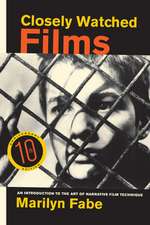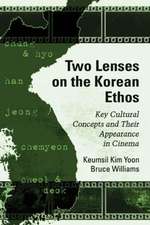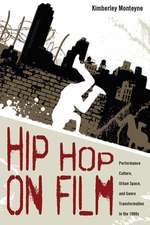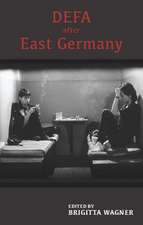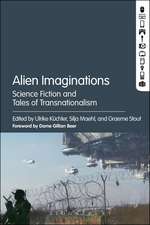The Bloomsbury Handbook of Global Screenplay Theory: Bloomsbury Handbooks
Editat de Andrew Kenneth Gay, Ann Igelstromen Limba Engleză Hardback – 12 iun 2024
Din seria Bloomsbury Handbooks
- 39%
 Preț: 696.17 lei
Preț: 696.17 lei - 43%
 Preț: 640.21 lei
Preț: 640.21 lei - 39%
 Preț: 673.52 lei
Preț: 673.52 lei - 45%
 Preț: 141.20 lei
Preț: 141.20 lei - 43%
 Preț: 637.37 lei
Preț: 637.37 lei - 44%
 Preț: 626.47 lei
Preț: 626.47 lei - 43%
 Preț: 685.76 lei
Preț: 685.76 lei - 43%
 Preț: 638.78 lei
Preț: 638.78 lei - 43%
 Preț: 635.75 lei
Preț: 635.75 lei - 44%
 Preț: 626.47 lei
Preț: 626.47 lei - 10%
 Preț: 218.15 lei
Preț: 218.15 lei - 43%
 Preț: 197.67 lei
Preț: 197.67 lei - 43%
 Preț: 731.21 lei
Preț: 731.21 lei - 44%
 Preț: 673.52 lei
Preț: 673.52 lei - 41%
 Preț: 208.18 lei
Preț: 208.18 lei - 44%
 Preț: 673.52 lei
Preț: 673.52 lei - 44%
 Preț: 626.47 lei
Preț: 626.47 lei - 43%
 Preț: 632.80 lei
Preț: 632.80 lei - 43%
 Preț: 634.04 lei
Preț: 634.04 lei - 43%
 Preț: 631.68 lei
Preț: 631.68 lei - 43%
 Preț: 632.61 lei
Preț: 632.61 lei - 44%
 Preț: 626.47 lei
Preț: 626.47 lei - 43%
 Preț: 637.84 lei
Preț: 637.84 lei - 45%
 Preț: 137.40 lei
Preț: 137.40 lei - 44%
 Preț: 141.67 lei
Preț: 141.67 lei - 43%
 Preț: 824.17 lei
Preț: 824.17 lei - 12%
 Preț: 201.62 lei
Preț: 201.62 lei - 12%
 Preț: 198.96 lei
Preț: 198.96 lei -
 Preț: 821.51 lei
Preț: 821.51 lei - 39%
 Preț: 680.07 lei
Preț: 680.07 lei - 43%
 Preț: 633.96 lei
Preț: 633.96 lei -
 Preț: 129.81 lei
Preț: 129.81 lei - 21%
 Preț: 278.65 lei
Preț: 278.65 lei - 43%
 Preț: 682.24 lei
Preț: 682.24 lei - 41%
 Preț: 208.30 lei
Preț: 208.30 lei - 43%
 Preț: 631.97 lei
Preț: 631.97 lei - 43%
 Preț: 679.49 lei
Preț: 679.49 lei - 44%
 Preț: 673.52 lei
Preț: 673.52 lei - 44%
 Preț: 721.05 lei
Preț: 721.05 lei - 22%
 Preț: 889.49 lei
Preț: 889.49 lei - 44%
 Preț: 814.68 lei
Preț: 814.68 lei - 21%
 Preț: 228.89 lei
Preț: 228.89 lei - 43%
 Preț: 686.61 lei
Preț: 686.61 lei - 43%
 Preț: 730.91 lei
Preț: 730.91 lei - 41%
 Preț: 218.88 lei
Preț: 218.88 lei - 43%
 Preț: 777.48 lei
Preț: 777.48 lei - 43%
 Preț: 732.44 lei
Preț: 732.44 lei
Preț: 889.49 lei
Preț vechi: 1281.77 lei
-31% Nou
Puncte Express: 1334
Preț estimativ în valută:
170.35€ • 175.51$ • 142.70£
170.35€ • 175.51$ • 142.70£
Carte disponibilă
Livrare economică 03-17 februarie
Preluare comenzi: 021 569.72.76
Specificații
ISBN-13: 9781501394065
ISBN-10: 1501394061
Pagini: 592
Dimensiuni: 178 x 254 mm
Greutate: 0.45 kg
Editura: Bloomsbury Publishing
Colecția Bloomsbury Academic
Seria Bloomsbury Handbooks
Locul publicării:New York, United States
ISBN-10: 1501394061
Pagini: 592
Dimensiuni: 178 x 254 mm
Greutate: 0.45 kg
Editura: Bloomsbury Publishing
Colecția Bloomsbury Academic
Seria Bloomsbury Handbooks
Locul publicării:New York, United States
Caracteristici
Explores conventional, innovative, and transgressive screenplays in both studio and independent international contexts, including The Lion King and Slumdog Millionaire
Notă biografică
Andrew Gay is an Associate Professor of Digital Cinema at Southern Oregon University, USA. He has written pieces for the Journal of Screenwriting, Women Screenwriters: An International Guide, Toy Story: How Pixar Reinvented the Animated Feature, and in the forthcoming Handbook of Script Development, and the Open Educational Resource (OER) Screenplayology.com.Ann Igelstrom is an independent researcher based in Edinburgh, UK. She has written pieces for the Journal of Screenwriting and Screenwriters and Screenwriting: Putting Practice into Context. She serves as the Early Career Representative on the Screenwriting Research Network's council and is in charge of the Network's Facebook and Twitter accounts.
Cuprins
Introduction Andrew Kenneth Gay, Southern Oregon University, US and Ann Igelstrom, Independent Researcher, UKPart I: FADE IN: Theorizing ScreenplayIntroduction Andrew Kenneth Gay, Southern Oregon University, US and Ann Igelstrom, Independent Researcher, UKSection I. I: The Screenplay as Object1. An Ontology of the Screenplay as a Complex SystemPaolo Russo, Oxford Brookes University, UK2. Screenwriting in the Past Tense? Sergei Eisenstein's Theory of Literary Script, The General Line (1929), and the Use of Tenses in ScreenplaysAlexandra Ksenofontova, Germany3. Alan Sharp's Screenplay-Novel Hybrid Picture Yourself, and the Screenplay as Aesthetic ObjectRiver Seager, University of Dundee, UK4. Dance with Shadows: Screenwriting and the Diegetic Space in Brazilian Film HistoryRafael Lea, Pontifical Catholic University, BrazilSection I. II: The Screenplay as Process5. Characterization, Dialogue, and Performance in Lawrence Kasdan's Screenplay for Raiders of the Lost ArkBrett Davies, Meiji University, Japan6. Everything I Don't Remember: Adapting Characters and Their Migratory ExperiencesJoakim Hermansson, Dalarna University, Sweden7. Maryam's Windows and Marziyeh's Screens: Layers of Processes, Poetics, and Authorship in 3 Faces, by Jafar PanahiMárcio Andrade, Independent Scholar, Brazil8. A Taxonomy for Writing Biopics based on Scant Evidence: The Return of Martin Guerre and Victoria & AbdulIndranil Chakravarty, LV Prasad Academy of Film & TV, IndiaSection I. III: The Screenplay as Character and Meaning9. "Such a foreign presence in Herfordshire": Screenwriting Black Female Nobility into British Heritage CinemaClaudia Sternberg, University of Leeds, Uk10. A Watchful Eye: the Dramatic Utility and Narrative Application of the Child's Gaze in En du elsker/Someone You Love (2014)Cath Moore, University of Melbourne (Australia)11. Exploring Characterization and Theme in the Screenwriting Process: The Case of GladiatorCarmen Sofia Brenes, Universidad Gabriela Mistral, Chile and Universidad Internacional de la Rioja, Spain12. Why Women Keep A Star (being) Born: How an 80 Year Franchise is Alive and Well Due to the Characterization and Dialogue of Female Screenwriters and the Performance of Female SuperstarsRosanne Welch, Stephens College, US13. Moonlight and Mosquita y Mari: Centering the Black and Brown LGBTQ Coming of Age Narrative in CinemaElisha Miranda, San Jose State University, US and Desha Dauchan, University of California, Irvine, USPart II: INT./EXT. The Screenplay as Narrative TextIntroductionAndrew Kenneth Gay, Southern Oregon University, US and Ann Igelstrom, Independent Researcher, UKSection II.I: Narrative Structure in the Screenplay14. Imposing New Hollywood Structure on the Remake of 3:10 to YumaMads Larsen, University of California, Los Angeles, US15. Narrative Structure in Mari Okada's Maquia: When the Promised Flower Blooms, Japan (2018)Max Gee, Bournemouth University, UK16. Narrative Structure in the Screenplay of The Naked Island (1960)Lauri Kitsnik, Hiroshima University, Japan17. Narrative Structure in the Iranian Screenplay: Analysing Story Shape in Asghar Farhadi's The SalesmanChris Neilan, Manchester Metropolitan University, UKSection II.II: Narration and Focalization in the Screenplay18. Writing Perspective and Perception into the Screenplay: The Case of I Lost My Body (2019)Carina Böhm, Central Queensland University, Australia and Craig Batty, University of South Australia, Australia19. "THE CAMERA IS JEAN-DOMINIQUE BAUBY": Focalizing Locked-In Syndrome in The Diving Bell and the ButterflyAndrew Kenneth Gay, Southern Oregon University, US20. The Hole at the Centre of the Donut: A Question of Character Perspective and Focalization in Knives OutAnn Igelstrom, Independent Researcher, UK21. Writing the Viewer: Narration and Perspective in a Cinematic Virtual Reality ScreenplayKath Dooley, Curtin University, AustraliaSection II.III: Narrative Time in the Screenplay22. Time is Relative: a Modern and Postmodern Approach to Time in Kubrick's ShiningKerstin Stutterheim, Academy of Media Arts Cologne, Germany23. Playing with Time and Voice-Over in Eternal Sunshine of the Spotless MindAnn Igelstrom, Independent Researcher, UK24. Time, Narrative and Boyhood Carolina Amaral and Taiyo Omura, Independent Scholars, Brazil25. The Strange Case of Angelica: Time and Rhythm in Manoel de Oliveira's ScreenplayRita Benis, University of Lisbon, PortugalPart III: CUT TO: The Screenplay as Cinematic LanguageIntroductionAndrew Kenneth Gay, Southern Oregon University, US and Ann Igelstrom, Independent Researcher, UKSection III.I: Mise-en Scene and Cinematic Space in the Screenplay26. Visual Dramaturgy: From Miami Vice to Game of ThronesKerstin Stutterheim, Academy of Media Arts Cologne, Germany27. The Dramatic Space in Beto Brant's Films: Confining and Expanding the CharactersRubens Rewald, University of São Paulo, Brazil28. Theme and the Humble Watermelon: The Battle for Identity in Sweet CountryGlenda Hambly, Monash University, AustraliaSection III.II: Cinematography and Editing in the Screenplay29. The Woman is Framed: Representing the Gaze in the Screenplay, One in a Million GirlLouise Sawtell, University of South Australia, Australia30. An Analysis of the Cinematographic and Editing Elements in the Screenplay for Federico Fellini's Le notti di Cabiria/Nights of CabiriaClaudia Romanelli, University of Alabama, US31. The Cut in Slumdog MillionaireGreg Loftin, Ravensbourne University London, UK32. Whatever Feels Right: Options for the Cut in Lynn Shelton's Your Sister's Sister ScriptmentAndrew Kenneth Gay, Southern Oregon University, USSection III.III: Sound and Music in the Screenplay33. Sound Design and Music Proposals in Lucrecia Martel's Swamp ScreenplayIana Cossoy Paro, EICTV International Film School, Cuba34. Screenwriting in Waltz Time: Role and Function of Music in the Walter Reisch's Screenplay for Two Hearts in Waltz Time (AT 1930)Claus Tieber, University of Vienna, Austria35. "What a Wonderful Phrase": Sequence, Selection and Scenography in the Animated Musical Screenplay, The Lion King (1994)Paul Wells, Loughborough University, UKBibliographyIndex


